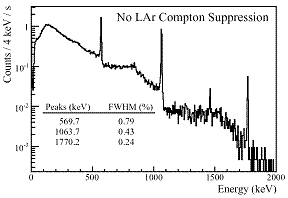
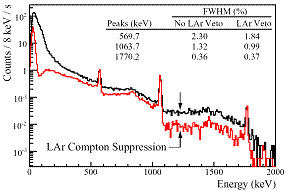
Outline | Back to Outline |
Basic Research | Back to Outline |
The Majorana Project | Back to Outline |
 Are neutrinos Dirac or Majorana type particles? These names refer to the theoretical physicists who developed mathematical formulations for the description of the neutrino. The neutrino, unlike all other elementary fermions, has no electric charge. This lack of charge allows for the two different formulations, attributed to the theorists mentioned above. Determining the Dirac or Majorana nature of the neutrino is a major goal of current neutrino research. One way to determine this is to look for an extremely rare nuclear decay that is only allowed if neutrinos are Majorana type particles. In this rare decay, a nucleus simultaneously emits two beta particles without emitting the two neutrinos that are required for normal nuclear beta decays. This process is called neutrinoless double beta decay and is depicted here with the lowest order Feynman diagram.
Are neutrinos Dirac or Majorana type particles? These names refer to the theoretical physicists who developed mathematical formulations for the description of the neutrino. The neutrino, unlike all other elementary fermions, has no electric charge. This lack of charge allows for the two different formulations, attributed to the theorists mentioned above. Determining the Dirac or Majorana nature of the neutrino is a major goal of current neutrino research. One way to determine this is to look for an extremely rare nuclear decay that is only allowed if neutrinos are Majorana type particles. In this rare decay, a nucleus simultaneously emits two beta particles without emitting the two neutrinos that are required for normal nuclear beta decays. This process is called neutrinoless double beta decay and is depicted here with the lowest order Feynman diagram.
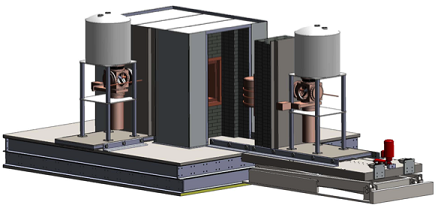 I am currently involved with the Majorana Project which is an experiment to search for this extremely rare nuclear decay that would be a signature of the Majorana nature of the neutrino. Another extremely important question in neutrino physics is, "What is the absolute mass of the neutrino?" The rate (half-life) of neutrinoless double beta decay is related to the absolute mass of the neutrino. The determination of these two properties of the neutrino is critical a more complete understanding of these elementary particles. These ideas are vindicated by the American Physical Society's Joint Study on the Future of Neutrino Physics: The Neutrino Matrix which recommended as a high priority a neutrinoless double beta decay experiment. The Majorana DEMONSTRATOR is currently underway at the Sanford Underground Research Facility (SURF). The Majorana DEMONSTRATOR apparatus is shown here without the external neutron moderation shield, revealing the lead gamma-ray shield and the interior copper cryostats which hold the germanium detectors.
I participated in an interview with South Dakota Public Broadcasting's Innovation at SURF in July 2011. Here is a YouTube video of the interview underground; I join the discussion about 30 minutes into the show and talk about neutrinoless double beta decay and the Majorana experiment.
I am currently involved with the Majorana Project which is an experiment to search for this extremely rare nuclear decay that would be a signature of the Majorana nature of the neutrino. Another extremely important question in neutrino physics is, "What is the absolute mass of the neutrino?" The rate (half-life) of neutrinoless double beta decay is related to the absolute mass of the neutrino. The determination of these two properties of the neutrino is critical a more complete understanding of these elementary particles. These ideas are vindicated by the American Physical Society's Joint Study on the Future of Neutrino Physics: The Neutrino Matrix which recommended as a high priority a neutrinoless double beta decay experiment. The Majorana DEMONSTRATOR is currently underway at the Sanford Underground Research Facility (SURF). The Majorana DEMONSTRATOR apparatus is shown here without the external neutron moderation shield, revealing the lead gamma-ray shield and the interior copper cryostats which hold the germanium detectors.
I participated in an interview with South Dakota Public Broadcasting's Innovation at SURF in July 2011. Here is a YouTube video of the interview underground; I join the discussion about 30 minutes into the show and talk about neutrinoless double beta decay and the Majorana experiment.
Coherent Neutrino Scattering | Back to Outline |
Dark Matter | Back to Outline |
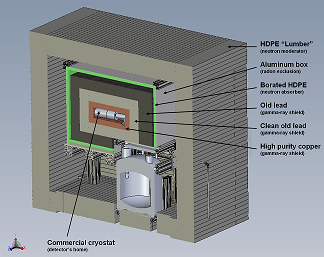 Interestingly the same technique used for measuring coherent neutrino scattering is also well suited for attempting direct detection searches for WIMP dark matter. In the case of dark matter one is looking for the interaction of a massive weakly interacting particle which is supposed to play an important role in the formation of galaxies. That is to say, the luminous matter seen in galaxies with telescopes does not have enough gravitational pull to keep them from flying apart. Hence there must be some "dark matter" which is providing the gravitational mass to hold galaxies together. Currently we have a detector located at Soudan Underground Laboratory attempting to look for very low energy nuclear recoils which would be the tell-tale sign of dark matter particles 'bouncing' off nuclei in our germanium gamma-ray spectrometer. I've posted more details on a separate page here: CoGeNT Dark Matter Experiment.
Interestingly the same technique used for measuring coherent neutrino scattering is also well suited for attempting direct detection searches for WIMP dark matter. In the case of dark matter one is looking for the interaction of a massive weakly interacting particle which is supposed to play an important role in the formation of galaxies. That is to say, the luminous matter seen in galaxies with telescopes does not have enough gravitational pull to keep them from flying apart. Hence there must be some "dark matter" which is providing the gravitational mass to hold galaxies together. Currently we have a detector located at Soudan Underground Laboratory attempting to look for very low energy nuclear recoils which would be the tell-tale sign of dark matter particles 'bouncing' off nuclei in our germanium gamma-ray spectrometer. I've posted more details on a separate page here: CoGeNT Dark Matter Experiment.
Direct Immersion of HPGe in Liquid Argon | Back to Outline |

| 
|
Applied Research | Back to Outline |
Nuclear Non-Proliferation | Back to Outline |
Cadmium Zinc Telluride (CZT) Spectrometer Development | Back to Outline |
 Current state-of-the-art gamma-ray detector technology relies upon liquid nitrogen to cool the sensitive detection elements. This cooling apparatus is bulky and difficult to transport. Cadmium zinc telluride crystals provide the potential for portable, room-temperature gamma-ray detection with competitive energy resolution and sensitivity. The Pacific Northwest National Laboratory is over-seeing a multifaceted materials and radiation detection investigation of CZT. The goal of the program is to assist in bringing high-quality (defined as spectroscopic grade) CZT material to the level of a practical and, thus, profitable manufacturing status.
Current state-of-the-art gamma-ray detector technology relies upon liquid nitrogen to cool the sensitive detection elements. This cooling apparatus is bulky and difficult to transport. Cadmium zinc telluride crystals provide the potential for portable, room-temperature gamma-ray detection with competitive energy resolution and sensitivity. The Pacific Northwest National Laboratory is over-seeing a multifaceted materials and radiation detection investigation of CZT. The goal of the program is to assist in bringing high-quality (defined as spectroscopic grade) CZT material to the level of a practical and, thus, profitable manufacturing status.
Dissertation Work | Back to Outline |
Sudbury Neutrino Observatory | Back to Outline |
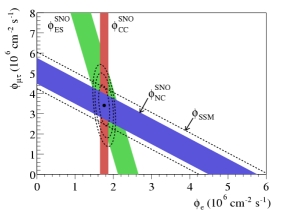 The Sudbury Neutrino Observatory (SNO) experiment is credited with solving the "solar neutrino problem", a 40 year long apparent deficit of the measured flux of solar neutrinos, as measured here on Earth. The resolution of this problem was the determination that approximately two-thirds of the neutrinos produced by the Sun's internal fusion reactions, change flavor, from electron to muon or tau, by the time they arrive at the Earth. This figure shows the three different measurements that the SNO experiment can make. Previous experiments were only sensitive to the type of reactions represented by the red and green bands. The SNO experiment's ability to add this third type of measurement, the blue band, showed conclusively the flux of electron neutrinos (horizontal axis) and muon or tau neutrinos (vertical axis) matches the prediction of the Standard Solar Model (SSM), represented by the dashed, black lines. This result is only possible if neutrinos are massive particles, confirming previous observations of neutrino flavor change and the massive nature of neutrinos.
The Sudbury Neutrino Observatory (SNO) experiment is credited with solving the "solar neutrino problem", a 40 year long apparent deficit of the measured flux of solar neutrinos, as measured here on Earth. The resolution of this problem was the determination that approximately two-thirds of the neutrinos produced by the Sun's internal fusion reactions, change flavor, from electron to muon or tau, by the time they arrive at the Earth. This figure shows the three different measurements that the SNO experiment can make. Previous experiments were only sensitive to the type of reactions represented by the red and green bands. The SNO experiment's ability to add this third type of measurement, the blue band, showed conclusively the flux of electron neutrinos (horizontal axis) and muon or tau neutrinos (vertical axis) matches the prediction of the Standard Solar Model (SSM), represented by the dashed, black lines. This result is only possible if neutrinos are massive particles, confirming previous observations of neutrino flavor change and the massive nature of neutrinos.
Dr. Arthur B. McDonald - 2015 Nobel Prize in Physics | Back to Outline |
Solar Electron Antineutrinos? | Back to Outline |
